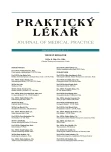Resilience of family with handicapped child
Authors:
L. Sikorová; Z. Birteková
Authors‘ workplace:
Vedoucí: doc. PhDr. Darja Jarošová, PhD.
; Děkan: doc. MUDr. Arnošt Martínek, CSc.
; Ústav ošetřovatelství a porodní asistence LF OU
; Lékařská fakulta Ostravské univerzity v Ostravě, Ostrava
Published in:
Prakt. Lék. 2011; 91(8): 477-481
Category:
Of different specialties
Overview
The paper presents results of an investigation, whose aim was to assess the resilience of families with handicapped child based on the concept of Hardiness. The partial objective of the investigation was to determine differences in resilience depending on
- the functionality of the family,
- family composition,
- type of handicap of the child and
- to determine the use of compensatory mechanisms in stressful situations in a family.
The t-test was used to determine the relationship between family characteristics and assessed questionnaire items. Comparison of multiple variables was performed by using analysis of variance - ANOVA.
The results revealed moderate to high resilience of families with handicapped children. The investigation also revealed that families are predominantly functional. The survey confirmed that families with handicapped child use compensatory mechanisms for coping. It is primarily about communication within the family, family planning, joint leisure time, active and positive approach to problem solving and communication with the external environment. An essential step for coping in a family with a handicapped child is to enable the family to live a sensual and full life, without any restriction. The cooperation of involved professionals and families is essential, so that between them a mutual trust is created, especially between the family, the child’s GP and the youth and child nurse.
Key words:
family, handicap, child, resilience of family.
Sources
1. Green, S.E. „What do you mean what wrong with her?“ stigma and the lives of families of children with disabilities. Soc. Sci. Med. 2003, 57(8), p. 1361-1374.
2. Křivohlavý, J. Nezdolnost typu hardiness. Cesk. Psychol. 1991, 35(1), s. 59-65.
3. Langmeier, J., Krejčířová, D. Vývojová psychologie. 2. vyd. Praha: Grada, 2006. 368 s. ISBN 80-247-1284-9.
4. Matoušek, O. Rodina jako instituce a vztahová síť. 3. vyd. Praha: Sociologické Nakladatelství, 2003. 161 s. ISBN 80-86429-19-9.
5. Paulík, K. Psychologie odolnosti. 1. vyd. Praha: Grada, 2010. 240 s. ISBN 978-80247-2959-65.
6. Pešová, I., Šamalík, M. Poradenská psychologie pro děti a mládež. 1. vyd. Praha: Grada, 2006. 152 s. ISBN 80-247-1216-4.
7. Pěč, O., Probstová, V. eds. Psychózy - psychoterapie, rehabilitace a komunitní péče. 1. vyd. Praha: Triton, 2009. 256 s. ISBN 978-80-7387-253-3.
8. Plaňava, I. Manželství a rodiny. 1. vyd. Brno: Doplněk, 2000. 296 s. ISBN 80-7239-039-2.
9. Shapiro, J. Family reactions and coping strategies in response to the physically ill or handiccaped child: A Review. Soc. Sci. Med. 1983, 17(14), p. 913-931.
10. Sobotková, I. Pěstounské rodiny: Jejich fungováni a odolnost. Praha: MPSV. 2003. 142 s. ISBN 80-865552-62-4.
11. Sobotková, I. Psychologie rodiny. Praha: Portál, 2007. 219 s. ISBN 978-80-7367-250-8.
12. Strnadová, L., Květoňová, L. Speciálně-pedagogická intervence v rodinách osob s postižením. E-Pedagogium (online). Olomouc: Univerzita Palackého, 2010 (cit. 2011-04-02). Dostupné z WWW: <http://www.upol.cz/fileadmin/user_upload/PdF/e-pedagogium/e pedagogium_2010/e-pedagogium _2-2010_mimoradne.pdf>. ISSN 1213-7499.
Labels
General practitioner for children and adolescents General practitioner for adultsArticle was published in
General Practitioner

2011 Issue 8
- Hope Awakens with Early Diagnosis of Parkinson's Disease Based on Skin Odor
- Metamizole at a Glance and in Practice – Effective Non-Opioid Analgesic for All Ages
- Memantine Eases Daily Life for Patients and Caregivers
- Metamizole vs. Tramadol in Postoperative Analgesia
- Memantine in Dementia Therapy – Current Findings and Possible Future Applications
Most read in this issue
- Advances in operative treatment of fractures of upper and lower extremities
- Short intervention and first aid for patients with addictive diseases
- Study of four POCT systems for HbA1c measurement
- Problematic of doping in general practice
